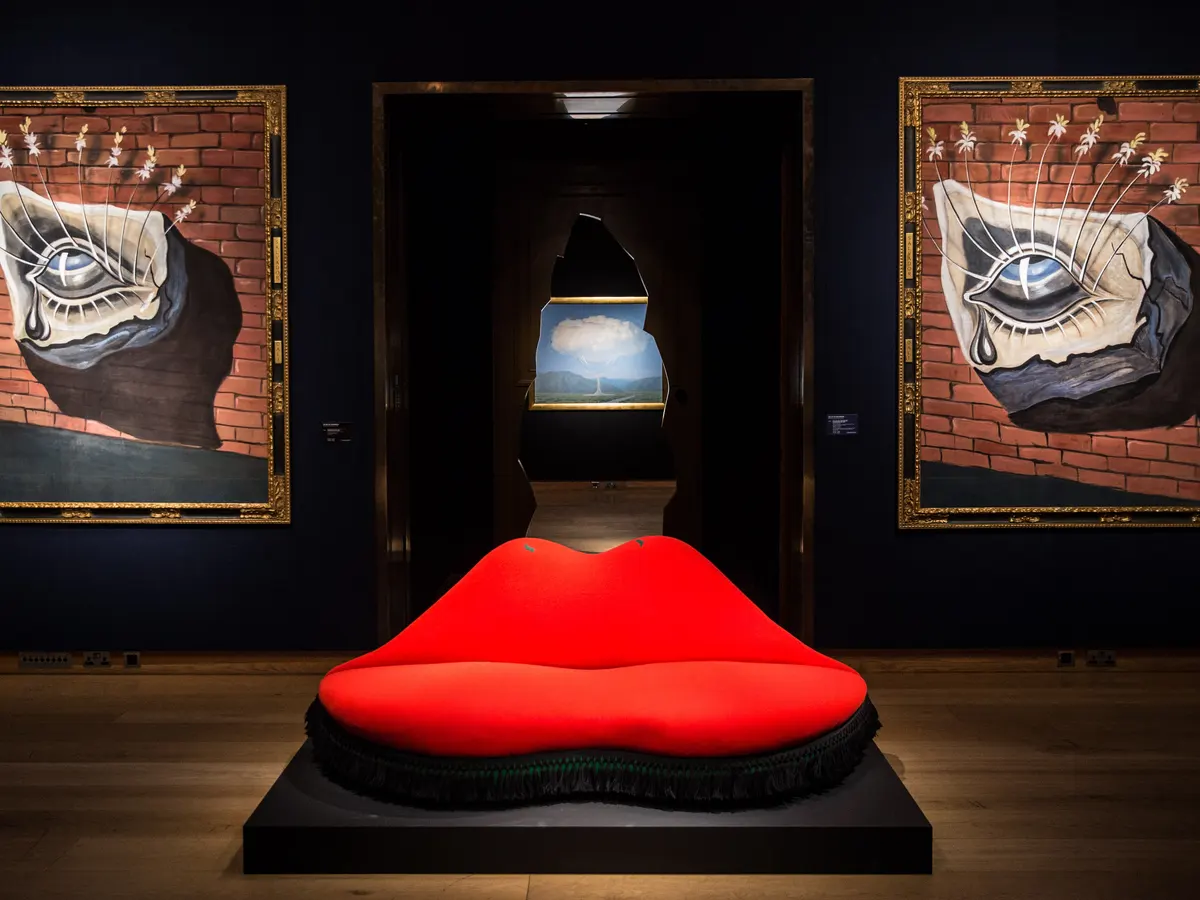Memelord Dalí Remembering Salvador Dalí (May 11, 1904–January 23, 1989)
Posted By Nicholas R. Jeelvy On In North American New Right1,741 words
It’s the most basic thing in the world: You can look at a rock, think it’s a bear, and run away. Or you can glimpse a bear, assume it’s a rock, and get eaten. Over time, evolution will select for seeing bears, when in fact, 99 times out of 100, it’s just rocks. Then clever fools will come and say that believing in a bear infestation is primitive superstition, and that they, taught by “science” and “logic,” have surmised that there are no bears among the rocks. In fact, bears do not even exist. Then they tip their fedoras and strut around while looking very important, until such a time when they’re devoured by bears.
Fortunately, there exist such brilliant and great men who see bears everywhere, even where the ordinary man will not see a bear. Salvador Dalí was such a man.
Dalí’s method was called the paranoiac-critical method. Dalí sought to induce in himself a paranoid state so that he may better perceive connections between things and concepts, to allow himself a sort of secret knowledge which could then be used for the creation of art. If it sounds like magic, it’s because it is a potent form of magic. It’s how one conjures bears from rocks, transforms faux-sophisticates into byzantine plotters, and summons inter-dimensional shape-shifting child molesters from outer space. It’s how you see melting watches in a pot of stinky cheese and end up with Christ on a tesseract. We’re also living in this very world of everything having double and triple meanings, everyone with double and triple allegiances. It’s certainly proving to be very entertaining.
Dalí, like us, lived in a time when the fabric of reality was dissolving around him. We are ourselves in the end stages of that very same dissolution. His signature was the double image, the representation of two things with the same elements, often of something human and something animal, or sometimes something human with something decidedly inhuman, such as the aforementioned Jesus on a tesseract.
Dalí’s imagery was fitting for a period that lacked clarity. Indeed, his work assailed the very notion of clarity, the idea that things are just what they appear to be. Why shouldn’t gigantic. . . whatever the thing from The Great Masturbator is dominate a long perspective landscape of a vast and arid desert? Why shouldn’t the self-torturing monstrosity of Premonition of War revel in the boiled beans (a most musical vegetable, one certainly approved of by Dalí the flatulence-enjoyer [3])? Is it any more real than the motor car, the telephone, emerging global financial power, or the rise of Communism? Who’s to say? There’s a doddering, senile fool in the White House right now, and his administration, consisting entirely of affirmative action hires, is on the hunt for invisible white supremists. Personally, I’m ready to believe in the boiled beans thing.
If you want to see surreal, go no further than the nearest internet imageboard or wherever the kids post their memes these days. Some are crude and deliberately nonsensical, such as the glottal stop in the store. Others are subtler, such as the juxtaposition of the anodyne whiteness intended in White Boy Summer with the intensity of Stalin, Tito, and Jared the Subway Guy. Yes, I know they’re technically white boys. The smug, shit-eating grin we imagine the creator of those memes must have felt is part of the surreal experience. It hovers over the image itself as we play out a brief drama in our heads: one part played by an incredulous normie wondering what Tito, Stalin, and Jared have to do with White Boy Summer (while secretly knowing what it’s all about), and the purported creator, some shitlord with a backward-turned hat grinning inanely in his sense of smug superiority.
If Dalí were alive today, he’d be running a meme page, not only because that’s the bleeding edge of surreal art, but also because the man was a shameless narcissist and self-promoter. Watching his appearance on What’s My Line [6], I think of two things. One, this guy really needs to be all-encompassing, and two, this guy is a troll. Look at how he enjoys messing with the panel, who dub him a “misleading man.” Doesn’t he look like a meme himself? Doesn’t he presage the “Yes Chad” meme?
 [7]
[7]You can buy Kerry Bolton’s Artists of the Right here [8].
Or maybe he’d be something grander than a humble memelord. He’d have to take center stage in whatever productions he organized. Merely combining an image with words, or image with image, or a glottal stop with the grocery aisle wouldn’t be enough for him. Wouldn’t this ridiculous-looking character be better suited to warning us about literal vampire potbelly goblins, chemicals turning the frogs gay, or massive election fraud, which all turn out to be true? It wouldn’t surprise me.
Every great showman is great because he’s on the bleeding edge of entertainment. Entertainment is novelty, and the bleeding edge in the empire of lies is the truth. So, what you’re saying is that no, diversity is not our strength, America is not a nation of immigrants, much less so the nations of Europe, and democracy is not the best system of government? I’m shocked — shocked, I tell you!
They derisively call us “edgelords,” because we’re genuinely outside the narrow bounds of prescribed morality and aesthetics. To become an edgelord is a process of self-transformation not dissimilar to the paranoiac-critical method of Dalí. It entails burning away the rationality that the modern world forces upon us. No, of course you’re not safe; there’s a cabal of evil fucks out to exterminate you, your family, and your people — and by the way, your job enslaves you to this very system that seeks your destruction.
The advocate for globalism — a SHORT, asthmatic dwarf fueled by resentment towards White Chads who smacked him around when he was in grade school — will try to make contemptible noises and use “facts” and “logic” to disabuse you of your “irrational” beliefs, but is promptly BTFO’d by an image of his large-breasted sister who is also Anne Frank in the form of a lampshade. Imagery — potent, vulgar, irreverent imagery in lieu of argumentation — it’s what Cioran would have wanted and what Dalí enjoyed. The latter’s love affair with sea creatures and in particular seafood underscored his own voyeuristic sexuality. And by historic standards, every man under the age of 35 is a voyeur. Even the most sexually successful of us have seen more women get fucked on a screen than we’ve fucked.
Whatever the eye can see, the mind can distort, mold, hold, transform, invert, make liquid, make risible, make ridiculous, bottom text [9]. If Dalí were alive today, he’d be dicking around in Photoshop.
If there’s anything we can learn from the period between 2015 and 2018, it’s that cultural power on the edge comes from a place of authenticity and relaxation. Our great power was culture-creation, or more precisely culture-dissolution and culture-jamming. In 2017, the Dissident Right turned to politics and got its ass handed to it by the establishment for various reasons. Then, the big political thinkers got it in their heads that we should “do culture,” and suddenly, our cultural activities became inauthentic and rigid. Soon after, online dissident culture was swamped by bad actors who wanted to steer it in various directions, the two most dangerous ones being Right-wing terrorism and Right-wing cringe. Our great mistake was believing in the cargo-cult of political culture. We see liberal culture garner success and believe it is effective, not taking into account that the great success of mainstream art may be due to the fact that it’s on TV [11] (or on the radio). We imagined artistic success as popular success, where we should have reached for the stars.
Dali was immensely popular during his life and he had a knack for self-promotion, but he never compromised his vision, even when the communists of official Surrealism drummed him out for his “refusal to condemn fascism.” He was a supporter of General Franco and the Spanish monarchy, and later in life returned to Catholicism, and this shines through in his later art. He never moderated himself to appeal to the masses and never lost his ability to display transgressive truth, to shock, and to entertain. He was never locked up in an ivory tower, but always “in the shit” — designing fashion, film and theatre sets, jewelry, and furniture.
Slowly, Dalí put the surreal little by little in mundane reality. His chais lounge in the shape of Mae West’s lips has been replicated numerous times. To me, it’s an uproarious visual joke (she eats your ass, get it?). To others, a grotesque evocation of Kronus consuming his children (you sit in her mouth, get it?). Seeing this chais lounge, I am reminded of an image of a man with a donut on his penis. Inherently funny in one way, a tragic metaphor of our society’s caloric chains around the sexual locus in another.
What’s traditionalist, Right-wing, or conservative about all this? Everything and nothing. I won’t call myself a friend of conservatism, as you can read here [13]. What is “traditionalist?” Everything and nothing. It depends on whether you’re a small- or big-T traditionalist. What is Right-wing? There’s nothing more Right-wing than killing what is already dying, of dissolving what is already dead. It clears away the structures of idolatry and sclerosis which arise in the wake of dying civilizations. We are the acid that dissolves the dead. The knee-jerk reaction is to sneer and to cry degenerate, but sometimes the best we can do at a civilization’s end cycle is laugh on the way down.
Dalí laughed, uproariously, and he made people laugh as the world liquefied around them. I’m inviting you, each to the best of your ability, to do the same.
* * *
We would like to draw your attention to the following works on this site:
About Salvador Dalí:
- James J. O’Meara reviews Sex Surrealism, Dali and Me [3]
- Fenek Solère, “Salvador Dalí: Monarchist, Maniac, & Mage,” Part I [14], Part II [15], Part II [16]
Making substantial reference to Dalí:
- Jonathan Bowden, “Classical Modernism & the Art of the Radical Right [17]“
- Léon Degrelle, “The Enigma of Hitler [18]“
See also articles tagged [19] Salvador Dalí.
* * *
Counter-Currents has extended special privileges to those who donate $120 or more per year.
- First, donor comments will appear immediately instead of waiting in a moderation queue. (People who abuse this privilege will lose it.)
- Second, donors will have immediate access to all Counter-Currents posts. Non-donors will find that one post a day, five posts a week will be behind a “paywall” and will be available to the general public after 30 days.
To get full access to all content behind the paywall, sign up here:
Paywall Gift Subscriptions
 [20]If you are already behind the paywall and want to share the benefits, Counter-Currents also offers paywall gift subscriptions. We need just five things from you:
[20]If you are already behind the paywall and want to share the benefits, Counter-Currents also offers paywall gift subscriptions. We need just five things from you:
- your payment
- the recipient’s name
- the recipient’s email address
- your name
- your email address
To register, just fill out this form and we will walk you through the payment and registration process. There are a number of different payment options.





